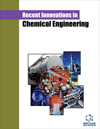- Home
- A-Z Publications
- Recent Innovations in Chemical Engineering (Formerly Recent Patents on Chemical Engineering)
- Previous Issues
- Volume 15, Issue 4, 2022
Recent Innovations in Chemical Engineering (Formerly Recent Patents on Chemical Engineering) - Volume 15, Issue 4, 2022
Volume 15, Issue 4, 2022
-
-
Mass Transfer of Olanzapine in the Liquid Lamellar Phases Formed by the Self-assembly of Glycerol Monooleate (GMO): Experimental Data and Mathematical Modeling
More LessAuthors: Mehdi Khanali and Gita BagheriAim: The present study aimed to optimise the formulation of Olanzapine (OZ)-loaded liquid lamellar phase by using Response Surface Methodology (RSM). Background: In this study, poly (2-ethyl-2-oxazoline) (PEOZ) was selected to modify liquid lamellar phases. The OZ was released from the phases mainly through swelling and diffusion-controlled mechanism simultaneously. Objective: Additionally, two types of mathematical Read More
-
-
-
Silicon Prismanes: Calculation and Comparison of Heats of Formation
More LessAuthors: Elena A. Zauer and Alexander B. ErshovBackground: The objects of this work are silicon prismanes - new highenergy materials that can be used in various electronic, optoelectronic, thermoelectric, and biological fields and compete with traditional chemical energy carriers. However, only compounds with hexasilacubane and octasilacubane have been synthesized to date. Synthesis of other silapismanes, and even more so polysilaprismanes, has not yet been a Read More
-
-
-
Effect of Amorphousness Degrees and Intermolecular Interactions between Lithium Perchlorate (LiClO4) and Polylactic Acid (PLA) on the Conductivity PLA-Based Polymer Electrolyte Performance
More LessBackground: The polymer electrolyte membrane serves as a separator and electrolyte in an energy storage device. The structural properties of the host polymer electrolyte have a significant impact on the conductivity value. Objective: The purpose of this study is to investigate the effect of amorphousness and intermolecular interaction degrees between LiClO4 and PLA on the conductivity performance of prepared PLA- bas Read More
-
-
-
Enhancing the Overall Heat Transfer Coefficient through Tube Rotation of a Heat Exchanger: An Analytical Approach
More LessBackground: Flow in an annulus between two concentric cylinders or pipes is very often observed, ranging its applications in many streams, namely, in steam generators, condensers, petroleum science and engineering, and various flow devices in chemical processing industries. The objective is to prove or understand the essence of parameters like heat transfer coefficient, mass transfer coefficient, etc., depending o Read More
-
-
-
Experimental Studies and Comparative Analyses on Apparent Viscosity of Solid Particle, Droplet, and Bubble Suspensions
More LessAuthors: Mingjun Pang, Shihuan Zhang and Ruipeng NiuBackground: Suspensions can be frequently seen in natural, industrial, and agricultural processes. The addition of dispersed phases (such as solid particles, droplets, and bubbles) greatly affects the rheological properties of matrix liquid. Therefore, it is very important to understand the rheological properties of particle suspensions for optimizing production processes and improving process efficiencies. Objective: To expl Read More
-
Most Read This Month
Article
content/journals/rice
Journal
10
5
false
en


